Charles E W Bean, Diaries, AWM38 3DRL 606/264/1 - 1914 - 1938 - Part 3
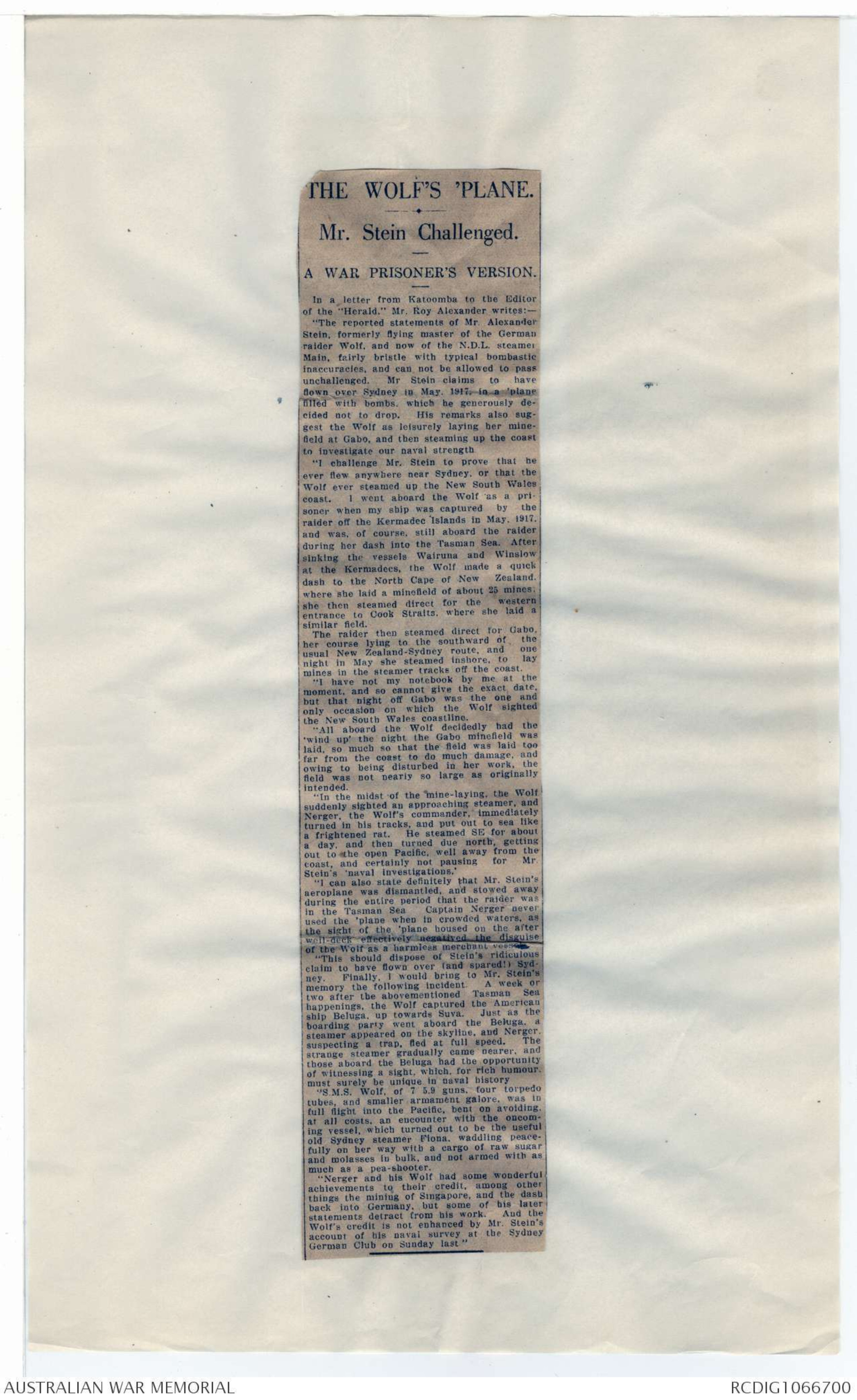
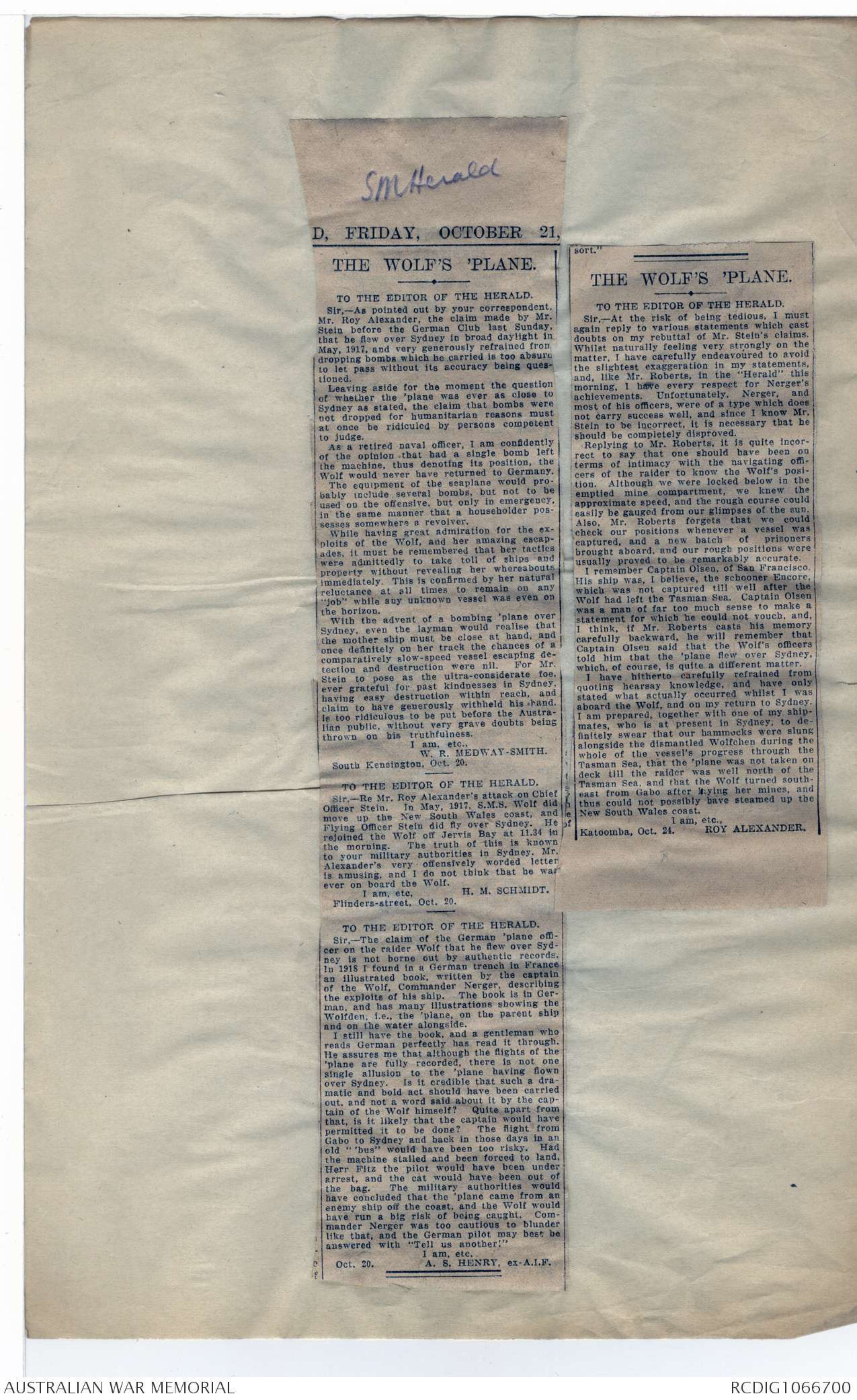

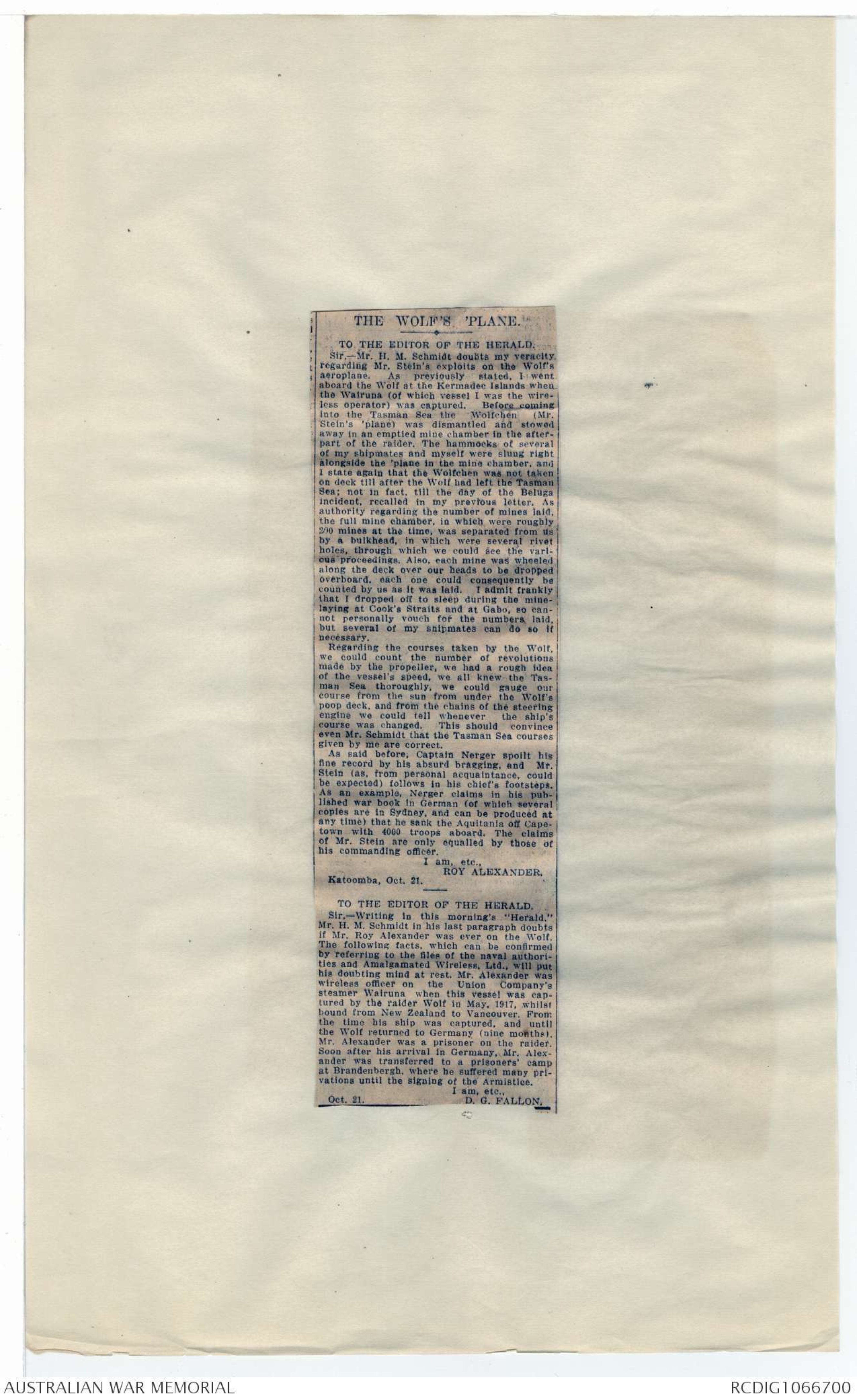

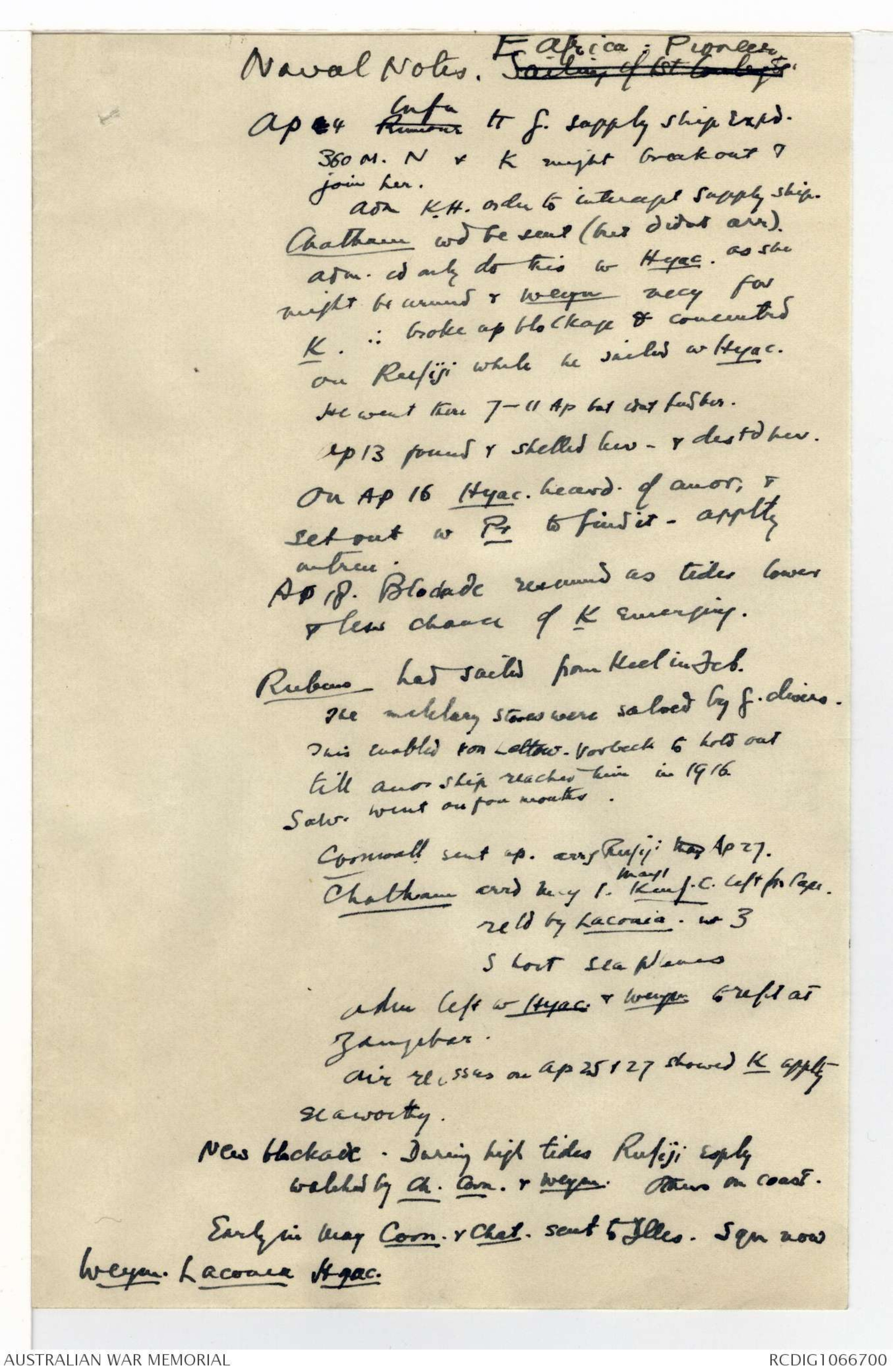
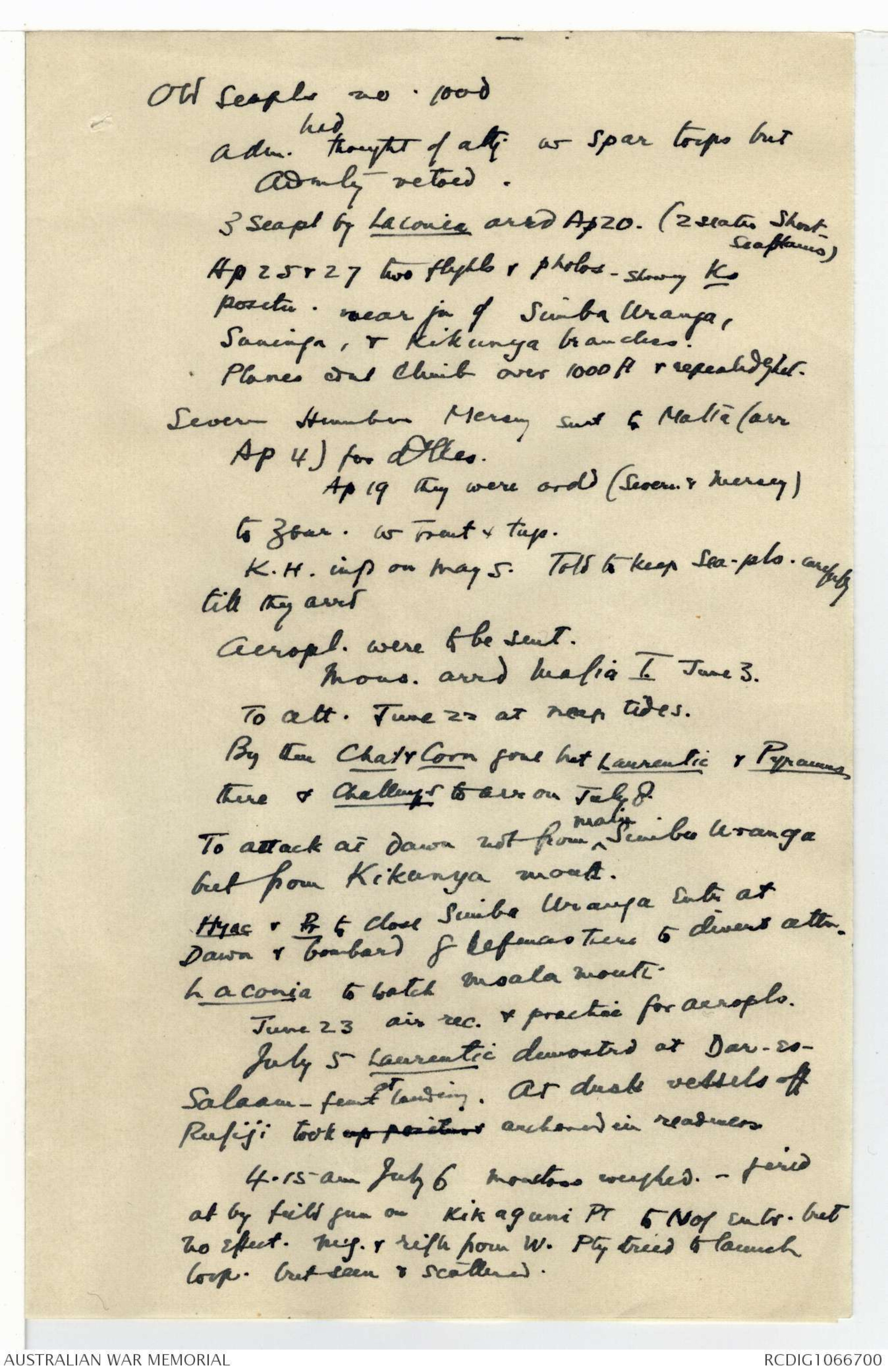
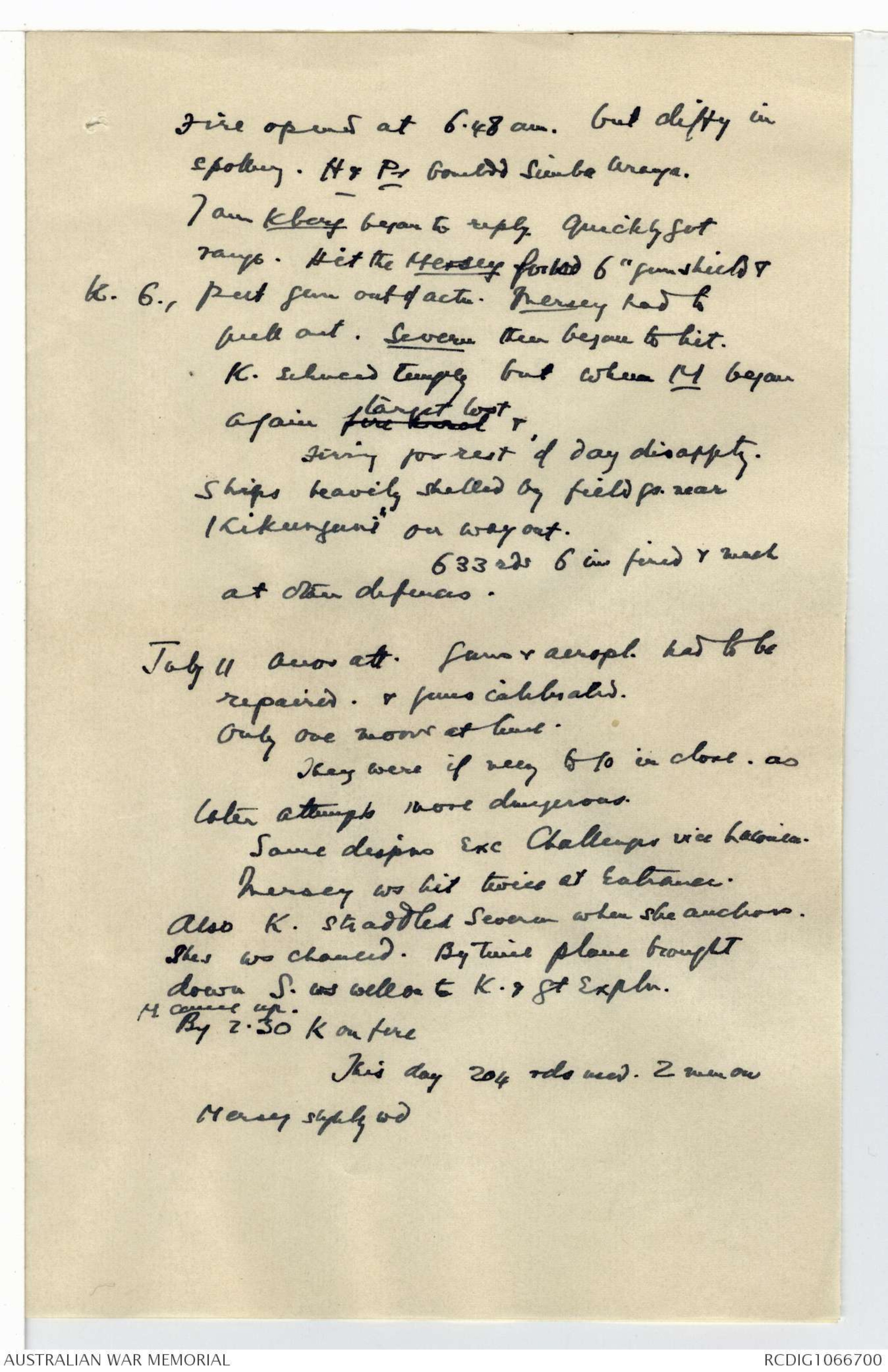
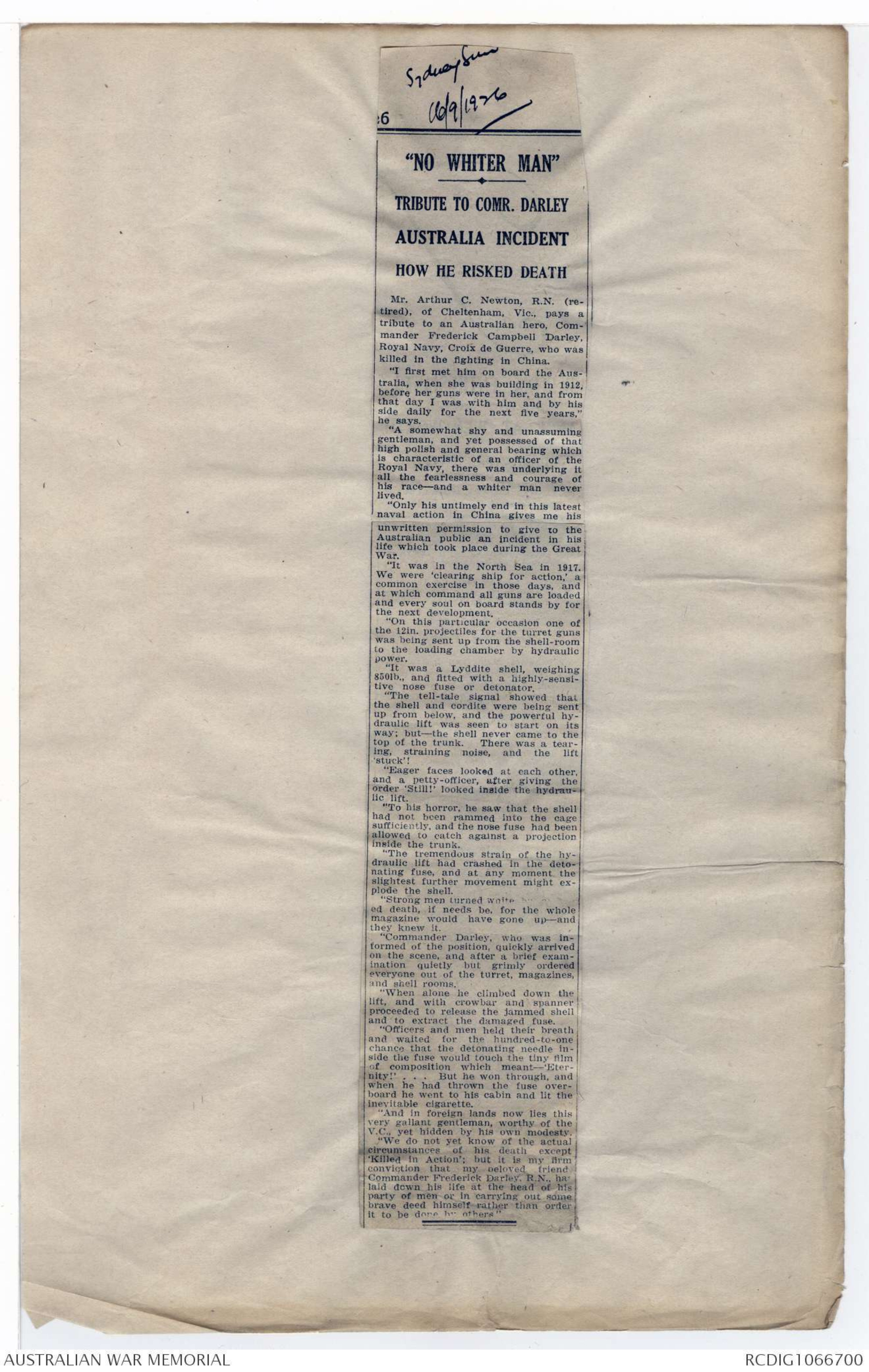

THE WOLF'S 'PLANE.
Mr. Stein Challenged.
A WAR PRISONER'S VERSION.
In a letter from Katoomba to the Editor
of the "Herald," Mr. Roy Alexander writes:-
"The reported statements of Mr. Alexander
Stein, formerly flying master of the German
raider Wolf, and now of the N.D.L. steamer
Main, fairly bristle with typical bombastic
inaccuracies, and can not be allowed to pass
unchallenged. Mr Stein claims to have
flown over Sydney in May, 1917, in a 'plane
filled with bombs, which he generously decided
not to drop. His remarks also suggest
the Wolf as leisurely laying her minefield
at Gabo, and then steaming up the coast
to investigate our naval strength.
"I challenge Mr. Stein to prove that he
ever flew anywhere near Sydney, or that the
Wolf ever steamed up the New South Wales
coast. I went aboard the Wolf as a prisoner
when my ship was captured by the
raider off the Kermadec Islands in May, 1917,
and was, of course, still aboard the raider
during her dash into the Tasman Sea. After
sinking the vessels Wairuna and Winslow
at the Kermadecs, the Wolf made a quick
dash to the North Cape of New Zealand,
where she laid a minefield of about 25 mines;
she then steamed direct for the western
entrance to Cook Straits, where she laid a
similar field.
The raider then steamed direct for Gabo,
her course lying to the southward of the
usual New Zealand-Sydney route, and one
night in May she steamed inshore, to lay
mines in the steamer tracks off the coast.
"I have not my notebook by me at the
moment, and so cannot give the exact date,
but that night off Gabo was the one and
only occasion on which the Wolf sighted
the New South Wales coastline.
"All aboard the Wolf decidedly had the
'wind up' the night the Gabo minefield was
laid, so much so that the field was laid too
far from the coast to do much damage, and
owing to being disturbed in her work, the
field was not nearly so large as originally
intended.
"In the midst of the mine-laying, the Wolf
suddenly sighted an approaching steamer, and
Nerger, the Wolf's commander, immediately
turned in his tracks, and put out to sea like
a frightened rat. He steamed SE for about
a day, and then turned due north, getting
out to the open Pacific, well away from the
coast, and certainly not pausing for Mr.
Stein's 'naval investigations.'
"I can also state definitely that Mr Stein's
aeroplane was dismantled and stowed away
during the entire period that the raider was
in the Tasman Sea. Captain Nerger never
used the 'plane when in crowded waters, as
the sight of the 'plane housed on the after
well-deck effectively negatived the disguise
of the Wolf as a harmless merchant vessel.
"This should dispose of Stein's ridiculous
claim to have flown over (and spared!) Sydney.
Finally, I would bring to Mr. Stein's
memory of the following incident. A week or
two after the abovementioned Tasman Sea
happenings, the Wolf captured the American
ship Beluga, up towards Suva. Just as the
boarding party went aboard the Beluga, a
steamer appeared on the skyline, and Nerger,
suspecting a trap, fled at full speed. The
strange steamer gradually came nearer, and
those aboard the Beluga had the opportunity
of witnessing a sight, which, for rich humour,
must surely be unique in naval history
"S.M.S. Wolf, of 7 5.9 guns, four torpedo
tubes, and smaller armament galore, was in
full flight into the Pacific, bent on avoiding,
at all costs, an encounter with the oncoming
vessel, which turned out to be the useful
old Sydney steamer Fiona, waddling peacefully
on her way with a cargo of raw sugar
and molasses in bulk, and not armed with as
much as a pea-shooter.
"Nerger and his Wolf had some wonderful
achievements to their credit, among other
things the mining of Singapore, and the dash
back into Germany, but some of his later
statements detract from his work. And the
Wolf's credit is enhanced by Mr. Stein's
account of his naval survey at the Sydney
German Club on Sunday last."
[*SM Herald*]
D, FRIDAY, OCTOBER 21,
THE WOLF'S 'PLANE.
TO THE EDITOR OF THE HERALD.
Sir,—As pointed out by your correspondent,
Mr. Roy Alexander, the claim made by Mr.
Stein before the German Club last Sunday,
that he flew over Sydney in broad daylight in
May, 1917, and very generously refrained from
dropping bombs which he carried is too absurd
to let pass without its accuracy being questioned.
Leaving aside for the moment the question
of whether the 'plane was ever as close to
Sydney as stated, the claim that bombs were
not dropped for humanitarian reasons must
at once be ridiculed by persons competent
to judge.
As a retired naval officer, I am confidently
of the opinion that had a single bomb left
the machine, thus denoting its position, the
Wolf would never have returned to Germany.
The equipment of the seaplane would probably
include several bombs, but not to be
used on the offensive, but only in emergency,
in the same manner that a householder possesses
somewhere a revolver.
While having great admiration for the exploits
of the Wolf, and her amazing escapades,
it must be remembered that her tactics
were admittedly to take toll of ships and
property without revealing her whereabouts
immediately. This is confirmed by her natural
reluctance at all times to remain on any
"job" while any unknown vessel was even on
the horizon.
With the advent of a bombing 'plane over
Sydney, even the layman would realise that
the mother ship must be close at hand, and
once definitely on her track the chances of a
comparatively slow-speed vessel escaping detection
and destruction were nil. For Mr.
Stein to pose as the ultra-considerate foe,
ever grateful for past kindnesses in Sydney,
having easy destruction within reach, and
claim to have generously withheld his hand,
is too ridiculous to be put before the Australian
public, without very grave doubts being
thrown on his truthfulness.
I am, etc.,
W. R. MEDWAY-SMITH.
South Kensington, Oct. 20.
TO THE EDITOR OF THE HERALD.
Sir,—Re Mr. Roy Alexander’s attack on Chief
Officer Stein. In May, 1917. S.M.S. Wolf did
move up the New South Wales coast, and
Flying Officer Stein did fly over Sydney. He
rejoined the Wolf off Jervis Bay at 11.34 in
the morning. The truth of this is known
to your military authorities in Sydney. Mr.
Alexander’s very offensively worded letter
is amusing, and I do not think that he was
ever on board the Wolf..
I am, etc, H. M. SCHMIDT.
Flinders-street, Oct. 20.
TO THE EDITOR OF THE HERALD.
Sir.—The claim of the German 'plane officer
on the raider Wolf that he flew over Sydney
is not borne out by authentic records.
In 1918 I found in a German trench in France
an illustrated book, written by the captain
of the Wolf, Commander Nerger, describing
the exploits of his ship. The book is in German,
and has many illustrations showing the
Wolfden, i.e., the 'plane, on the parent ship
and on the water alongside.
I still have the book, and a gentleman who
reads German perfectly has read it through.
He assures me that although the flights of the
'plane are fully recorded, there is not one
single allusion to the 'plane having flown
over Sydney. Is it credible that such a dramatic
and bold act should have been carried
out, and not a word said about it by the captain
of the Wolf himself? Quite apart from
that, is it likely that the captain would have
permitted it to be done? The flight from
Gabo to Sydney and back in those days in an
old "'bus" would have been too risky. Had
the machine stalled and been forced to land,
Herr Fitz the pilot would have been under
arrest, and the cat would have been out of
the bag. The military authorities would
have concluded that the 'plane came from an
enemy ship off the coast, and the Wolf would
have run a big risk of being caught. Commander
Nerger was too cautious to blunder
like that, and the German pilot may best be
answered with "Tell us another!"
I am, etc.
A.S. HENRY, ex A.I.F.
Oct. 20.
sort."
THE WOLF'S 'PLANE.
TO THE EDITOR OF THE HERALD.
Sir.—At the risk of being tedious, I must
again reply to various statements which cast
doubts on my rebuttal of Mr. Stein's claims.
Whilst naturally feeling very strongly on the
matter, I have carefully endeavoured to avoid
the slightest exaggeration in my statements,
and, like Mr. Roberts, in the "Herald" this
morning, I have every respect for Nerger's
achievements. Unfortunately, Nerger, and
most of his officers, were of a type which does
not carry success well, and since I know Mr.
Stein to be incorrect, it is necessary that he
should be completely disproved.
Replying to Mr. Roberts, it is quite incorrect
to say that one should have been on
terms of intimacy with the navigating officers
of the raider to know the Wolf's position.
Although we were locked below in the
emptied mine compartment, we knew the
approximate speed, and the rough course could
easily be gauged from our glimpses of the sun.
Also, Mr. Roberts forgets that we could
check our positions whenever a vessel was
captured, and a new batch of prisoners
brought aboard, and our rough positions were
usually proved to be remarkably accurate.
I remember Captain Olsen, of San Francisco.
His ship was, I believe, the schooner Encore,
which was not captured till well after the
Wolf had left the Tasman Sea. Captain Olsen
was a man of far too much sense to make a
statement for which he could not vouch, and,
I think, if Mr. Roberts casts his memory
carefully backward, he will remember that
Captain Olsen said that the Wolf's officers
told him that the 'plane flew over Sydney,
which, of course, is quite a different matter.
I have hitherto carefully refrained from
quoting hearsay knowledge, and have only
stated what actually occurred whilst I was
aboard the Wolf, and on my return to Sydney.
I am prepared, together with one of my shipmates,
who is at present in Sydney, to definitely
swear that our hammocks were slung
alongside the dismantled Wolfchen during the
whole of the vessel’s progress through the
Tasman Sea, that the 'plane was not taken on
deck till the raider was well north of the
Tasman Sea, and that the Wolf turned south-east
from Gabo after laying her mines, and
thus could not possibly have steamed up the
New South Wales coast.
I am, etc.,
ROY ALEXANDER.
Katoomba, Oct. 24.
[*Sydney Morning Herald
27/10/27.*]
THE WOLF'S PLANE.
TO THE EDITOR OF THE HERALD.
Sir,—In this morning's issue a Mr. Burton
is writing, on what authority I know not, stating
that he disbelieves Mr. Alexander’s statement
that the Wolf's seaplane never flew
over Sydney. He states that the Wolf's commander
says in his memoirs, by which I presume
he means the book published by Captain
Nerger on his return to Germany, that
the 'plane flew over Sydney. This is not correct,
as I have the book in question translated
into English, and no such statement is
made. If Mr. Stein ever made the statement
that he flew over Sydney in the Wolf's 'plane
then he is saying what is not true. Mr.
Alexander’s statement is the true version, and
any of the 400 odd prisoners on the Wolf will
vouch for it as the truth. Another of your
correspondents to-day also doubts Mr. Alexander's
account of the prisoners knowing the
position of the Wolf. I may state that we
were never more than 30 miles out in the
ship’s position, which we checked whenever
another ship was captured, by getting the
position from the master of the captured vessel.
He is also quite wrong in thinking that
there is anything in my book suggesting that
the 'plane ever flew over Sydney. Should any
further particulars be required I shall only be
too glad to give you them on my return to Sydney,
as I have none of my papers here with
me.
I am, etc.,
A. DONALDSON,
Master, M.V. Malabar.
Master late S.S. Matunga, sunk by
S.M.S. Wolf.
Blackheath, Oct. 24.
TO THE EDITOR OF THE HERALD.
Sir,—Indicative of the difficulties of historians
after a lapse of years is the controversy over
the statement of Captain Stein about bombing
Sydney. In May, 1917, about the time it was
subsequently found the mines were laid off
Gabo, which wrecked the Cumberland, the
then chief clerk of the Works Department,
one Wm. Selkirk, who resided at Watson's
Bay, told me one morning that a 'plane was
distinctly heard by himself and family passing
over their home early that morning. I
induced my friend, Colonel Lyster (then retired)
to go with me to the barracks, and
we reported the story to the Commandant.
He 'phoned South Head Fort. who reported
that they had not heard anything. The following
morning, at about 3 o'clock, Mr. Selkirk
and his family, whom he awakened, all heard
another 'plane over Watson’s Bay. Again
I reported it to the authorities, who could
not credit the possibility. The Wolf was
then unknown.
Now for the sequel. When in London during
the Armistice, I met Captain Rugg, the
well-known skipper of the Neotsfield, who
has many friends in Sydney. He told me
he had just returned from Germany, where
he had been a prisoner of war. His ship, the
Dee, trading from Mauritius to the Celebes
Islands, was the first vessel sunk by the
Wolf, and he remained a prisoner on board until
they reached Bremen. Captain Rugg (who
from his story, was generally accorded greater
freedom on board than most of the prisoners),
told me that after leaving Gabo, the
Wolf despatched once or twice (I forget
which) the seaplane over Sydney Harbour
to reconnoitre the disposition of our fleet.
Mr. Selkirk's story at the time might have
been imagination. Captain Rugg may have
been misatken. But the conflict in views only
goes to show what different evidence is
procurable on historical events.
I am. etc.,
Oct. 26. WATSONS BAY.
P.S.—Curiously enough, since writing the
foregoing, I have just received a letter from
Mr. Selkirk from North Queensland, reminding
me of the incident recorded, and my apparent
corroboration of his then unauthenticated
experience, on my return to Sydney in
1919.— W.B.
TO THE EDITOR OF THE HERALD.
Sir,—As chief engineer of the Wairuna, captured
June 2, 1917, by the German raider Wolf,
I can vouch for the accuracy of Mr. Alexander's
denial of the pilot of the Wolfchen's statement
that he flew over Sydney in his 'plane. After
the capture of the Wairuna and Winslow off
the Kermadec group, the sea-plane was between
decks until a few days before the capture
of the Matunga, In August, 1917, and, like
Mr. Alexander, I slept alongside it, so should
know. "In your issue of to-day a correspondent
"Edmund Roberts, D.S.C.," has some doubts in
his mind as to Mr. Alexander's knowledge of
the whereabouts of the Wolf whilst we were
prisoners, as it was hardly likely the officers
of the Wolf would tell us. Quite true, they
did not tell us, but from one who has some
knowledge of the sea and seamen it would be
quite simple. Captain McKenzie, of the
Ngatoro, who was chief officer of the Wairuna
at the time, had somehow secreted on his person
a small map of the world, and by the aid
of the sun by day and stars by night, he was
able to form a very good idea of the Wolf's
courses. I well remember when we left Farewell
Spit, Mr. McKenzie saying to me, "They are
making for Bass Straits." On the capture
of any ship after we were captured Mr.
McKenzie would get the position of that ship
on the previous days from the officers, and it
was a very easy matter to know our position,
and McKenzie would prick it off on his chart.
I did not desire to enter into this correspondence,
but when I read the letters of your
correspondents, who do not know the facts,
and who doubt whether Mr. Alexander was a
prisoner, I wished to verify Mr. Alexander's
statements, and to assure those who doubt that
the nightmare of being nine months a prisoner
of war on the Wolf will live for ever with
those who passed through this ordeal. The
facts and truth will not be forgotten.
I am, etc.,
ARTHUR S. CURRIE.
Paterson, Oct. 24.
THE WOLF'S 'PLANE.
TO THE EDITOR OF THE HERALD.
Sir,—Mr. H. M. Schmidt doubts my veracity
regarding Mr. Stein's exploits on the Wolf's
aeroplane. As previously stated, I went
aboard the Wolf at the Kermadec Islands when
the Wairuna (of which vessel I was the wireless
operator) was captured. Before coming
into the Tasman Sea the Wolfchen (Mr.
Stein's 'plane) was dismantled and stowed
away in an emptied mine chamber in the after-part
of the raider. The hammocks of several
of my shipmates and myself were slung right
alongside the 'plane in the mine chamber, and
I state again that the Wolfchen was not taken
on deck till after the Wolf had left the Tasman
Sea; not in fact, till the day of the Beluga
incident, recalled in my previous letter. As
authority regarding the number of mines laid,
the full mine chamber, in which were roughly
200 mines at the time, was separated from us
by a bulkhead, in which were several rivet
holes, through which we could see the various
proceedings. Also, each mine was wheeled
along the deck over our heads to be dropped
overboard, each one could consequently be
counted by us as it was laid. I admit frankly
that I dropped off to sleep during the mine-laying
at Cook's Straits and at Gabo, so cannot
personally vouch for the numbers laid,
but several of my shipmates can do so if
necessary.
Regarding the courses taken by the Wolf,
we could count the number of revolutions
made by the propeller, we had a rough idea
of the vessel’s speed, we all knew the Tasman
Sea thoroughly, we could gauge our
course from the sun from under the Wolf's
poop deck, and from the chains of the steering
engine we could tell whenever the ship's
course was changed. This should convince
even Mr. Schmidt that the Tasman Sea courses
given by me are correct.
As said before, Captain Nerger spoilt his
fine record by his absurd bragging, and Mr.
Stein (as, from personal acquaintance, could
be expected) follows in his chief's footsteps.
As an example, Nerger claims in his published
war book in German (of which several
copies are in Sydney, and can be produced at
any time) that he sank the Aquitania off Capetown
with 4000 troops aboard. The claims
of Mr. Stein are only equalled by those of
his commanding officer.
I am, etc.,
ROY ALEXANDER.
Katoomba, Oct. 21.
TO THE EDITOR OF THE HERALD.
Sir,—Writing in this morning's "Herald,"
Mr. H. M. Schmidt in his last paragraph doubts
if Mr. Roy Alexander was ever on the Wolf.
The following facts, which can be confirmed
by referring to the files of the naval authorities
and Amalgamated Wireless, Ltd., will put
his doubting mind at rest. Mr. Alexander was
wireless officer on the Union Company's
steamer Wairuna when this vessel was captured
by the raider Wolf in May, 1917, whilst
bound from New Zealand to Vancouver. From
the time his ship was captured, and until
the Wolf returned to Germany (nine months),
Mr. Alexander was a prisoner on the raider.
Soon after his arrival in Germany, Mr. Alexander
was transferred to a prisoners’ camp
at Brandenbergh, where he suffered many privations
until the signing of the Armistice.
I am, etc.,
D. G. FALLON.
Oct. 21.
[*3/11/27*]
THE WOLF'S SEAPLANE.
TO THE EDITOR OF THE HERALD.
Sir,—Anticipating your kindly permission I
offer the suggestion that the statements made
by Mr. Stein and by your various correspondents,
regarding the movements of the
"Wolf's" seaplane may be equally true, because
there is a period of two months for
which we possess no detailed record of the
"Wolf's" movements, and it was during this
period that Mr. Stein claims to have flown
over Sydney; i.e., in May, 1917. This blank
extends from March 30, when she sank the
bargue "Dee" (Captain J. B. Rugg), bound
from Mauritius to Bunbury, approximately 800
miles west of Cape Leeuwin, until she next
appears off Sunday Island, where she captured
the S.S. "Wairuna", on the June 2.
Although we cannot doubt the signed statements
made by Mr. Alexander, Mr. Currie,
and others, as to what occurred after they
were captured (June 2), it is obvious that
they would not have first-hand knowledge of
what was done before that date, and it is
only from Commander Nerger's book that we
learn briefly that his ship was cruising in
the Tasman Sea, during the two months referred
to.
Under foregoing circumstances we may be
permitted to reason from the known to the unknown,
guided by certain rules universally
followed in war time. Thus the "Wolf," being
a naval vessel, her commander would have
definite and positive instructions to obtain
and transmit all possible intelligence of naval
or military value; such as number and disposition
of warships, troopships, naval bases,
etc., and for this reconnaissance work his best
instrument would unquestionably be the seaplane
carried for such purposes: literally the
eyes of the "Wolf."
The fact that Commander Nerger in his
book makes no mention of having used the
"Wolfchen" for scouting along this piece of
coast, proves nothing either way. The book,
published before the war ended, would be
very strictly censored and under naval regulations,
its author would not be permitted to
make public anything resembling naval or
military intelligence, and must, therefore,
leave very much unsaid. Recognising these
restrictions, but carefully weighing the reasons
and probabilities, "for and against", the
scale inclines heavily to the conclusion that
the seaplane must have been used as stated
by Mr. Stein; a deduction supported by the
fact that she was admittedly used for scouting
in other areas.
Finally we may recall the numerous circumstantial
reports of unknown 'planes having
been seen in various places about the time;
reports that we are not justified in dismissing
as imaginary since many of them were made
by persons who could not be accused of wilfully
scaremongering. I am, etc.,
J.G.F.
Newcastle, Nov 1.
[*4/11/27*]
FRIDAY, NOVEMBER 4,
THE WOLF'S 'PLANE.
TO THE EDITOR OF THE HERALD.
Sir,—In the "Herald" this morning a correspondent,
"J.G.F.", suggests that Mr. Stein
may be correct in his claims to have flown
over Sydney and to have refrained from
bombing the city from humanitarian motives.
"J.G.F." suggests that no evidence is available
as to the Wolf's movements for two
months prior to the capture of the Wairuna,
on June 2, 1917, and that Captain Nerger may
possibly then have been in the Tasman Sea.
Unfortunately for Mr. Stein, indisputable evidence
is available fully accounting for the
raider’s movements during that period.
After sinking the Dee in the Indian Ocean,
the Wolf took a southerly course, which
brought her well south of Tasmania, so far
south that she eventually passed the Antipodes
Islands. By this time the Wolf was
six months out from Germany, and it was
essential to thoroughly clean her boilers and
overhaul her engines before venturing into
such dangerous waters as the Tasman Sea.
It is, therefore, a reasonable deduction that
this was the reason which impelled Nerger
to make the Kermadec Islands his temporary
base. He proceeded from the Antipodes Group
to the Kermadec Group to the eastward of
New Zealand, still keeping well out to sea,
and still very far from the Tasman Sea. This
information is available from Captain
Meadows and his men of the Turritella (captured
March, 1917), the crews of the steamers
Jumna and Wordsworth, and from the remarkably
detailed diary of the French mate
of the barque Dee.
Certainly the seaplane was used for scouting,
but only when well out to sea, where the
'plane would not render the Wolf's disguise
useless. Mr. Stein never left the Wolf in
more or less confined waters, never in the
Skager Rak, never in the North Atlantic,
never in the Java Sea, never in the Tasman
Sea.
"J.G.F.'s" final paragraph will amuse those
of our war-time authorities who were inundated
with various statements from reputable
citizens, which, of course, is inevitable in any
country during times of national excitement.
There is not a town from the Leeuwin to
Cape York which had not its inhabitants who
could swear to the passing of 'planes, and
even Zeppelin's and "lights in the sky," and
"roaring 'plane engines" were almost as
numerous as locusts. In sifting evidence on
these matters, circumstantial evidence can
never be considered alongside the statements
of dozens of reputable witnesses, including
skilled navigators and army officers, who
were actually aboard the Wolf from the
Indian Ocean back to Kiel, via the Southern
Ocean, the Pacific, the Tasman Sea, the Pacific
again, the Java Sea, the Indian Ocean
again, and the Atlantic, and their evidence
suggests Mr. Stein as a somewhat boastful
man anxious to rehabilitate himself as a
"good fellow" in the Australian-European
steamer trade, and with a sublime disregard
for truthfulness. I am etc.,
ROY ALEXANDER.
Nov. 3.
Naval Notes, Sailing of 1st Cxxleyx E Africa: Pioneer
Ap x4 Rumour Infn tt G. supply ship expd.
360 M. N & K might break out &
join her.
Adm. K. H. order to intercept supply ship.
Chatham wd be sent (but didnt arr).
adm. cd only do this w Hyac. as she
might be armed & Weyn necy for
K. ∴ broke up blockage & concentrd
on Rufiji while he sailed w Hyac.
He went there 7-11 Ap but cdnt find her.
Ap 13 found & shelled her - & destd her.
On Ap 16 Hyac. heard. of anor, &
set out w Pr to find it - applty
untrue.
Ap 18. Blockade resumed as tides lower
& less chance of K emerging.
Rubens had sailed from Kiel in Feb.
The military stores were salved by G. divers.
This enabled von Lettow-Vorbeck to hold out
till anor ship reached him in 1916.
Salv. went on for months.
Cornwall sent up. arrg Rufiji May Ap 27.
Chatham arrd May 1. May 1 Kenf. C. left for Cape.
reld by Laconia. w 3
Short sea planes
Adm left w Hyac. & Weym to reft at
Zanzibar.
Air rec.ssces on Ap 25 & 27 showed K apptly
seaworthy.
New blockade - During high tides Rufiji esply
watched by Ch. Corn. & Weym. Others on Coast.
Early in May Corn. & Chat. sent to Dlles. Sqn now
Weym. Laconia Hyac.
Old seapls no . good
adm. had thought of attg. w spar torps but
Admty vetoed.
3 seapl by Laconia arrd Ap 20. (2 seater Short-Seaplanes)
Ap 25 & 27 two flights & photos - showing Ks
positn. near jn of Simba Uranga,
Saninga, & Kikunya branches.
Planes cdnt climb over 1000 ft & repeatedly hit.
Severn Humber Mersey sent to Malta (arr
Ap 4) for Dlles.
Ap 19 they were ordd (Severn & Mersey)
to Zbar. w Trent & tugs.
K.H. imp on May 5. Told to keep sea-pls. carefully
till they arrd
Aeropl. were to be sent.
Mous. arrd Mafia I. June 3.
To att. June 22 at neap tides.
By these Chat & Corn gone but Laurentic & Pyramus
there & Challenger to arr on July 8.
To attack at dawn not from ^main Simba Uranga
but from Kikunya mouth.
Hyac & Pr to close Simba Uranga Entr at
Dawn & bombard G defences there to divert attn.
Laconia to watch Msala mouth.
June 23 air rec. & practice for aeropls.
July 5 Laurentic demostrd at Dar-es-Salaam
- feint at landing. At dusk vessels off
Rufiji took up position & anchored in readiness.
4.15 am July 6 [[Moustoss?]] weighed. - fired
at by field gun on Kikaguni Pt to N of entr. but
no effect. m.g. & rifle from W. Pty tried to launch
torp. but seen & scattered.
Fire opend at 6.48 am. but difty in
spotting. H & Pr bombdd Simba Uranga.
7 am Kberg began to reply. Quickly got
range. Hit the Mersey forwd 6" gun shield &
k. 6., put gun out of actn. Mersey had to
pull out. Severn then began to hit.
K. silenced temply but when M began
again fire control target lost &
firing for rest of day disapptg.
Ships heavily shelled by field gs. near
Kikungani on way out.
633 rds 6 in fired & much
at other defences.
July 11 anor att. guns & aeropl. had to be
repaired. & guns calibrated.
Only one moved at time.
They were if necy to go in close, as
later attempts more dangerous.
Same dispns exc Challenger vice Laconia.
Mersey ws hit twice at Entrance.
Also K. straddled Severn when she anchors.
This ws chanced. By time plane brought
down S. ws well on to K. & gt expln.
M. came up.
By 2.30 K on fire
This day 204 rds used. 2 men on
Mersey slightly wd
[*Sydney Sun
16/9/26*]
6
"NO WHITER MAN"
TRIBUTE TO COMR. DARLEY
AUSTRALIA INCIDENT
HOW HE RISKED DEATH
Mr. Arthur C. Newton, R.N. (retired),
of Cheltenham, Vic., pays a
tribute to an Australian hero, Commander
Frederick Campbell Darley,
Royal Navy, Croix de Guerre, who was
killed in the fighting in China.
"I first met him on board the Australia,
when she was building in 1912,
before her guns were in her, and from
that day I was with him and by his
side daily for the next five years,"
he says.
"A somewhat shy and unassuming
gentleman, and yet possessed of that
high polish and general bearing which
is characteristic of an officer of the
Royal Navy, there was underlying it
all the fearlessness and courage of
his race—and a whiter man never
lived.
"Only his untimely end in this latest
naval action in China gives me his
unwritten permission to give to the
Australian public an incident in his
life which took place during the Great
War.
"It was in the North Sea in 1917.
We were 'clearing ship for action,' a
common exercise in those days, and
at which command all guns are loaded
and every soul on board stands by for
the next development.
"On this particular occasion one of
the 12in. projectiles for the turret guns
was being sent up from the shell-room
to the loading chamber by hydraulic
power.
"It was a Lyddite shell, weighing
850lb., and fitted with a highly-sensitive
nose fuse or detonator.
"The tell-tale signal showed that
the shell and cordite were being sent
up from below, and the powerful hydraulic
lift was seen to start on its
way: but—the shell never came to the
top of the trunk. There was a tearing,
straining noise, and the lift
'stuck'!
"Eager faces looked at each other,
and a petty-officer, after giving the
order 'Still!' looked inside the hydraulic
lift.
"To his horror, he saw that the shell
had not been rammed into the cage
sufficiently, and the nose fuse had been
allowed to catch against a projection
inside the trunk.
"The tremendous strain of the hydraulic
lift had crashed in the detonating
fuse, and at any moment the
slightest further movement might explode
the shell.
"Strong men turned white
ed death, if needs be, for the whole
magazine would have gone up—and
they knew it.
"Commander Darley, who was informed
of the position, quickly arrived
on the scene, and after a brief examination
quietly but grimly ordered
everyone out of the turret, magazines,
and shell rooms.
"When alone he climbed down the
lift, and with crowbar and spanner
proceeded to release the jammed shell
and to extract the damaged fuse.
"Officers and men held their breath
and waited for the hundred-to-one
chance that the detonating needle inside
the fuse would touch the tiny film
of composition which meant—'Eternity!'
. . . But he won through, and
when he had thrown the fuse overboard
he went to his cabin and lit the
inevitable cigarette.
"And in foreign lands now lies this
very gallant gentleman, worthy of the
V.C., yet hidden by his own modesty.
"We do not yet know of the actual
circumstances of his death except
'Killed in Action'; but it is my firm
conviction that my beloved friend
Commander Frederick Darley R.N., has
laid down his life at the head of his
party of men or in carrying out some
brave deed himself rather than order
it to be done by others"
course quite naturally we had been
fortunate enough in spotting a sub
& the other guns crews we d were desperate
and fondling their triggers
All ships waited for the Australia to
indicate compass bearing of the enemy to by
wireless but nothing came through.
Then there was the incident where Capt Oliver
Backhouse himself fired one of the 4" guns at
a periscope. We had been waiting months
& months at high tension to fire at something
& at last our chance came. The Captain was
the first to see the periscope, & rushed to the
voice pipe to call the after guns crews to fire
but he got no answer. Again he called, "Voice pipe man!!"
No answer. He ran aft trained the gun & fired.
Then the voice pipe man came running to his station
Naturally there was an enquiry the next day
Result. The voice pipe man was in the only
natural place to find him. The W.C.
& so we lost our only chance of a sub.
A.C. Newton.
CHELT. 180
"Minart,"
Kingston Rd.,
Cheltenham
No 1406.
Dear Mr Bean,
I have to thank you for
your letter of the 16 relative to an article
published in the Sydney Sun concerning
the late Commander Darley.
Yes the story is quite true.
HMAS Australia off May Island. March 1917.
Darley & I were in the Fire Control Top preparing
for action when the thing happened.
I was the fire control officer and and assumed
Darleys position aloft whenever he left the Top.
but on this occasion we both decided after
being phoned from "Q Tunnel" to go down &
inspect the trouble. I saw the shell & the
nose fuse was completely buckled over due to
the strain of the hydraulic lift.
 Deb Parkinson
Deb ParkinsonThis transcription item is now locked to you for editing. To release the lock either Save your changes or Cancel.
This lock will be automatically released after 60 minutes of inactivity.